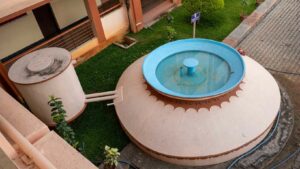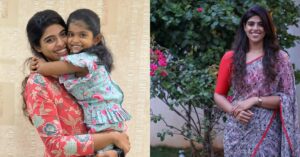Married at 15, Widowed at 18: How a Single Mom Became India’s 1st Woman Engineer!
“150 years ago, I would have been burned at the funeral pyre with my husband’s body," A Lalitha had famously said in a New York conference. Instead, she went on to make history!
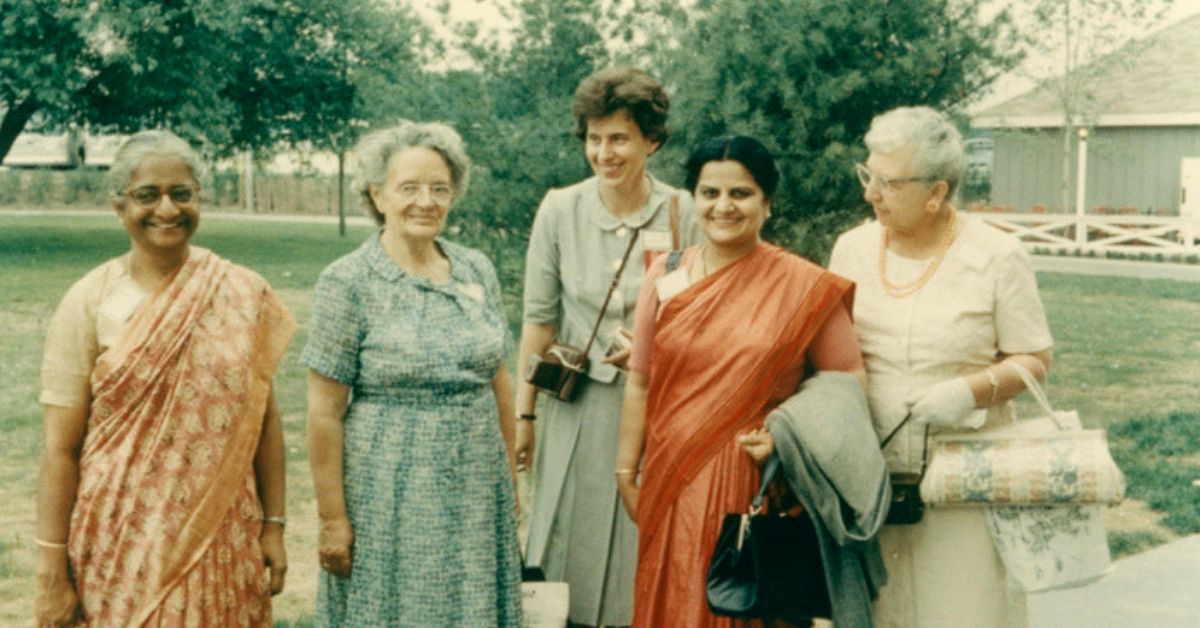
For A Lalitha, the responsibility of raising her four-month-old daughter was heavy. Married at the age of 15, Lalitha gave birth to a healthy, beautiful baby in the September of 1937 when she was 18. Just four months later, the teenage-mother lost her husband.
Baby Syamala was now the responsibility of a single mother.
Heads shaved, a strictly restricted life and banishment from society, the life of a widow was a prolonged trauma that they had no choice but to endure. Although the practice of Sati was less prevalent in Madras (now Chennai) where Lalitha had lived, societal standards still prescribed an austere life of isolation and perpetual sorrow to the young widow.
Instead, the forward-thinking and courageous Lalitha decided to overthrow all existing, outdated norms and pursue engineering. A male-dominated field then, Lalitha had made a decision that would make her India’s first female engineer!
Lalitha, fifth in the line of seven siblings was born on 27th August 1919. Her family was a typical middle-class Telugu family where the brothers had gone ahead to become engineers and the sisters were restricted to basic education. As was prevalent in those times, Lalitha was married off at the age of 15. Her father, however, insisted that a marital life should not interfere with her education and ensured that his daughter studied till class 10.
A mother’s instincts that made history:
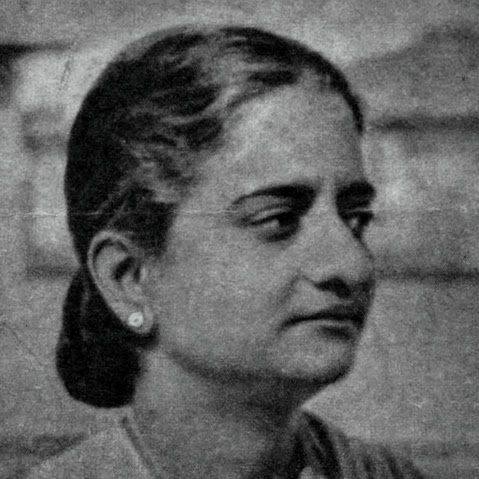
Lalitha’s story is just half a narrative if we don’t follow the journey of her daughter, Syamala Chenulu. Now settled in the USA, Syamala has fond memories of how her mother, an icon in the field of engineering, faced her challenges while raising her. Speaking to The Better India (TBI), Syamala says, “When my father passed away, mom had to suffer more than she should have. Her mother-in-law had lost her 16th child and took out that frustration on the young widow. It was a coping mechanism and today, I understand what she was going through. However, my mother decided not to succumb to societal pressures. She would educate herself and earn a respectable job.”
Medicine was quite a popular field for women in those times. However, medicine requires the professionals to be available round the clock and Lalitha did not want to fall into a profession that would require her to leave her baby in the middle of the night. She needed a typical 9 to 5 job that allowed the young mother to spend time with her beloved daughter.
Like her father, Pappu Subba Rao and her brothers, Lalitha chose to become an engineer.

Rao, a professor of Electrical Engineering at the College of Engineering, Guindy (CEG), University of Madras, spoke to KC Chacko, the Principal of the college and to the Director of Public Instruction, RM Statham. Both the officials were supportive of admitting a woman—a first in CEG’s history.
“Contrary to what people might think, the students at amma’s college were extremely supportive. She was the only girl in a college with hundreds of boys but no one ever made her feel uncomfortable and we need to give credit to this. The authorities arranged for a separate hostel for her too. I used to live with my uncle while amma was completing college and she would visit me every weekend,” Syamala tells us.
You may also like: This Amazing Book Celebrates India’s Pioneering Women Engineers. About Time!
A few months after Lalitha started her studies in 1940, she conveyed that though she was fine in the college, she was lonely in the hostel. Rao believed this was an opportunity to invite more women to follow his daughter’s path and advertised open admissions in CEG for women. Leelamma George and PK Thresia soon joined albeit for the civil engineering course.
“Both of them were juniors to my mother by a year. However, all three of them graduated together because the second world war was at its peak in 1944 and the university decided to cut down the engineering course by a few months,” Syamala explains.
A trailblazing engineer:

For a brief period after graduating from CEG, Lalitha worked with the Central Standard Organisation in Shimla as well as with her father in Chennai.
Fun fact: CEG had to remove the word ‘He’ from their printed certificates and replace it with ‘She’ for Lalitha, Thresia and Leelamma when they graduated.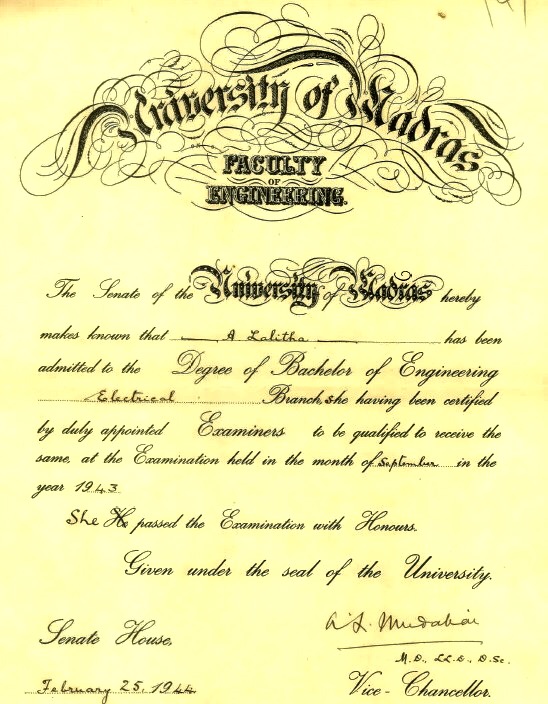
Rao invented Jelectromonium (an electrical musical instrument) as well as an electric flame producer and smokeless ovens. Lalitha had assisted him in these innovations. But within nine months of joining her father’s workshop, Lalitha started looking for other avenues and settled for a job in the Associated Electrical Industries in Kolkata.
Syamala explains, “My aunt lived in Kolkata and had a son about my age. We were very close and so, amma used to go to work leaving me with my cousin and aunt. That’s how I grew up. Although, today, I can understand how important my mother is in the history of women’s education in India as well as in the history of engineering, back then, all I knew was that my mom is an engineer—just another engineer.”
You may also like: How India’s First Woman Architect Blazed a Trail With Her Work on Chandigarh!
In the years to come, Lalitha’s achievements were to be recognised at international platforms too. In 1964, for instance, she was invited to the first International Conference of Women Engineers and Scientists (ICWES) in New York. It was during this conference that her mother’s importance as a professional really dawned upon Syamala.
“But what I take from her life is her extreme patience towards people and the quality of doing instead of just talking. She never remarried and never made me feel the absence of a father in my life. She believed that people come into your life for a reason and leave when the purpose is over. I never asked her why she never got married again. But when my husband asked her, she had replied, “To take care of an old man again? No, thank you!”
Throughout her career as an engineer, Lalitha had made sure of two important things—that her daughter is raised by loving people and that her being a woman in a male-dominated world would never be an obstacle. While attending the New York conference, she had very famously said, “150 years ago, I would have been burned at the funeral pyre with my husband’s body.”
Fortunately for women in India, she went on to become a trailblazing electrical engineer, lighting up the way for others to follow.
Lalitha passed away at a young age of 60 years due to a brain aneurysm but the legacy she has left behind is a gift for generations to come.
(Edited by Saiqua Sultan)
Like this story? Or have something to share? Write to us: [email protected], or connect with us on Facebook and Twitter.
This story made me
- 97
- 121
- 89
- 167
Tell Us More
We bring stories straight from the heart of India, to inspire millions and create a wave of impact. Our positive movement is growing bigger everyday, and we would love for you to join it.
Please contribute whatever you can, every little penny helps our team in bringing you more stories that support dreams and spread hope.






